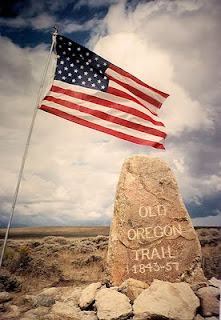Myth: The famous, and notorious, Oregon Trail was an approximately 2,000-mile trail extending from the Missouri River in the Midwest to the lush areas in and around Oregon on the West Coast of the United States. It was the American Dream incarnate. As Spanish and British disputes over Western territories came to a halt in 1848, Americans were free to travel westward, set up a new life for themselves on the rich terrain of the American Northwest, and with some hope, prosper. The trail flourished from the 1840s up until the 1860s when the transcontinental railroad came into existence and offered and cheaper and less dangerous approach. About 400,000 souls used the trail during its peak, traveling by foot, horseback or wagon in order to cash in on the idea of Manifest Destiny and the expanding United States of America.
Fact: Though the history books proclaim that the Oregon Trail was all in all a general success, this is in fact a blatant fallacy. Of the 400,000 businessmen, traders, explorers and ranchers utilizing the trail, some 375,000 of them perished, leaving only about 25,000 lucky citizens to actually complete the trail. Odd as it may seem, the iconic computer game, Oregon Trail, was in fact much more truthful in highlighting the realities of the trail and its pitfalls than any other esteemed historian to chronicle this momentous era. Historians argue that passage by ship around South America was much more perilous – what malarkey! As my research points out, many travelers were families. The average family consisted of two parents and approximately 8 to 12 children, all of whom shared the same name of either Sarah or Joseph, depending on sex of course. The first danger was often the leader of the wagon buying too many rounds of ammunition for hunting rather than stocking up on rations and medicine at the onset of the journey. As the trail consisted of many rivers crossing its path, each family was faced with the option of either floating the wagon across or attempting to ford the river. About 99 percent decided to ford the river since it was cheaper – and ironically enough, about 99 percent lost their supplies and horses, and maybe a few Sarahs in the process, as the wagon was inevitably swept away by the strong current. Another cause of the numerous deaths on the trail had to do with simple negligence on the part of the father. Even if meat supply was not a problem, the patriarch would often go out and hunt for days on end, forgetting what time of day it was and shooting at rabbits and squirrels for 72 hours. Proud of his 350-pound gain in meat, the father was often quickly saddened by two hard facts: 1) the wagon could only carry 12 more pounds and, 2) about 5 of his Sarahs had died of dysentery while he was away. Though these major setbacks occurred, the family tended to move onward, only to be attacked by bandits a few hours later and lose the 12 pounds of squirrel meat the father took 72 hours to acquire. If this weren’t bad enough, a bandit attack was usually followed by an Indian raid, in which about 5 Josephs were kidnapped, all of whom were suffering from dysentery at the time. About 1,000 miles into the journey, only husband and wife were left, but at least they had each other for the next 1,000 grueling miles. But wait. Statistics show that about 95 percent of the time, the wife became ill around mile marker 1,500 and died shortly after --- of dysentery. Archaeological digs around this area on the trail have unearthed thousands of ammunition rounds in the surrounding forests, directing one to the fact that the husband would often go into a “hunting frenzy” for about a week before deciding to commit suicide. But before most patriarchs could do away with themselves, many died a few days later --- of dysentery. The Oregon Trail was suicidal, to put it lightly, and one need look no further than the game for historical proof.

No comments:
Post a Comment